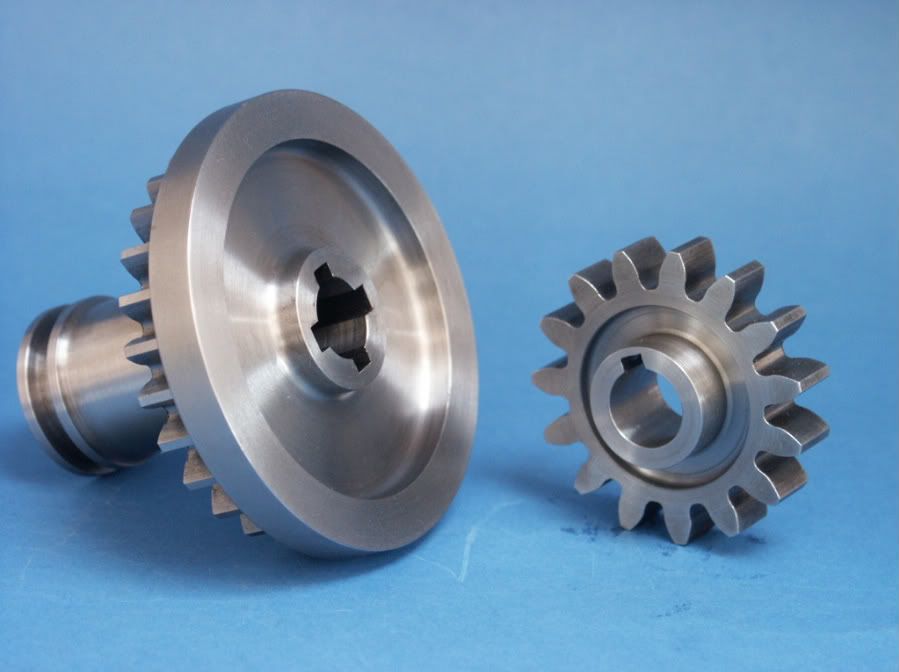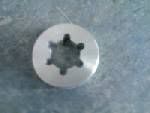mnewsholme
Member
- Joined
- Jul 24, 2008
- Messages
- 20
- Reaction score
- 0
Hi all
I've got an X3 mill and it doesnt feature a spindle lock. Normal method is to make a pin spanner to engage on a couple of holes on the bottom of the spinde but this is a bit awkward to use. The top of the spindle consists of a 20mm shaft with six equidistant 4mm wide by 2.5mm square splines on it. I'm making a knurled disc with the appropriate hole in the middle to drop over the shaft and give me something to grip when undoing drawbar. Making it as a disc rather than a spanner with thought that if I forget to take it off before staring up it wont go flying across shop.
I've got the disc made and the 20mm hole bored. I need some ideas how to cut the keyways. I've got a rotary table and obvious thought it use this to index the disc and mount a tool in mill spindle and use quill movement to shave the keyways out. Problem is lack of a spindle lock to keep the cutting tool in the correct orientation. obviously this would be done with power off.
what I'm thinking of doing is mounting disc in three jaw chuck on lathe and mount a appropriately ground tool in toolpost and using carriage travel to make the cut. I'd use a bar clamped to the saddle and push the jaw off the three jaw up tight against it to index the chuck. This would create 3 keyways 120 degrees apart. Then I loosen three jaw and rotate disc and move crosslide back so tool picks up one of alread cut keyways whilst jaws are tight against the bar on the saddle and re-tighten the chuck jaws. this should give me correct disc position relative to chuck jaws to but the remaining 3 slots.
Does this sound workable? material is aluminium.
If anyones got any blindingly obvious simple way of doing this that I'm overlooking I'd love to hear it.I'm trying to do it without having to make up extra tools to do the job first if I can avoid it. Wont have chance to try it till weekend anyway.
cheers
Matt
I've got an X3 mill and it doesnt feature a spindle lock. Normal method is to make a pin spanner to engage on a couple of holes on the bottom of the spinde but this is a bit awkward to use. The top of the spindle consists of a 20mm shaft with six equidistant 4mm wide by 2.5mm square splines on it. I'm making a knurled disc with the appropriate hole in the middle to drop over the shaft and give me something to grip when undoing drawbar. Making it as a disc rather than a spanner with thought that if I forget to take it off before staring up it wont go flying across shop.
I've got the disc made and the 20mm hole bored. I need some ideas how to cut the keyways. I've got a rotary table and obvious thought it use this to index the disc and mount a tool in mill spindle and use quill movement to shave the keyways out. Problem is lack of a spindle lock to keep the cutting tool in the correct orientation. obviously this would be done with power off.
what I'm thinking of doing is mounting disc in three jaw chuck on lathe and mount a appropriately ground tool in toolpost and using carriage travel to make the cut. I'd use a bar clamped to the saddle and push the jaw off the three jaw up tight against it to index the chuck. This would create 3 keyways 120 degrees apart. Then I loosen three jaw and rotate disc and move crosslide back so tool picks up one of alread cut keyways whilst jaws are tight against the bar on the saddle and re-tighten the chuck jaws. this should give me correct disc position relative to chuck jaws to but the remaining 3 slots.
Does this sound workable? material is aluminium.
If anyones got any blindingly obvious simple way of doing this that I'm overlooking I'd love to hear it.I'm trying to do it without having to make up extra tools to do the job first if I can avoid it. Wont have chance to try it till weekend anyway.
cheers
Matt






